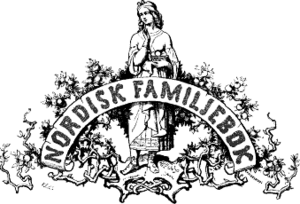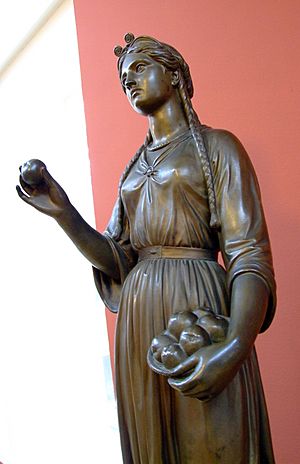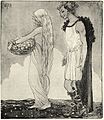Iðunn facts for kids
In Norse mythology, Iðunn (Old Norse:) is a goddess associated with apples and youth. Iðunn is attested in the Poetic Edda, compiled in the 13th century from earlier traditional sources, and the Prose Edda, written in the 13th century by Snorri Sturluson. In both sources, she is described as the wife of the skaldic god Bragi, and in the Prose Edda, also as a keeper of apples and granter of eternal youthfulness.
The Prose Edda relates how Loki was once forced by the jötunn Þjazi to lure Iðunn out of Asgard and into a wood with the promise of apples even fairer than her own. Þjazi, in the form of an eagle, abducts Iðunn from the wood, bearing her off to his home. Iðunn's absence causes the gods to grow old and grey, and they realize that Loki is responsible for her disappearance. Under duress, Loki promises to bring her back and, setting out in the form of a falcon, eventually finds her alone at Þjazi's home. He turns her into a nut and flies back toward Asgard. When Þjazi returns to find Iðunn gone, he assumes his eagle form once more and flies off in hot pursuit of Loki and his precious burden. The gods build a pyre in the courtyard of Asgard and, just as Loki has stopped short of it, kindle it. Unable to halt his frenzied onrush, Þjazi plunges headlong through the fire, falling to the ground with his feathers aflame, whereupon the gods attack and kill him.
A number of theories surround Iðunn, including potential links to fertility, and her potential origin in Proto-Indo-European religion. Long the subject of artworks, Iðunn is sometimes referenced in modern popular culture.
Contents
Name
The name Iðunn has been variously explained as meaning "ever young", "rejuvenator", or "the rejuvenating one". As the modern English alphabet lacks the eth (ð) character, Iðunn is sometimes anglicized as Idhunn, Idunn, Idun, or Ithun. An -a suffix is sometimes appended to denote femininity, resulting in forms such as Iduna and Idunna.
The name Iðunn appears as a personal name in several historical sources and the Landnámabók records that it has been in use in Iceland as a personal name since the pagan period (10th century). Landnámabók records two incidents of women by the name of Iðunn; Iðunn Arnardóttir, the daughter of an early settler, and Iðunn Molda-Gnúpsdóttir, granddaughter of one of the earliest settlers recorded in the book. The name Iðunn has been theorized as the origin of the Old English name Idonea. The 19th century author C.M. Yonge writes that the derivation of Idonea from Idunn is "almost certain," noting that although Idonea may be "the feminine of the Latin idoneus (fit), its absence in the Romance countries may be taken as an indication that it was a mere classicising of the northern goddess of the apples of youth."
The 19th century scholar Jacob Grimm proposed a potential etymological connection to the idisi. Grimm states that "with the original form idis the goddess Idunn may possibly be connected." Grimm further states that Iðunn may have been known with another name, and that "Iðunn would seem by Saem. 89a to be an Elvish word, but we do not hear of any other name for the goddess."
Modern influence

Iðunn has been the subject of a number of artistic depictions. These depictions include "Idun" (statue, 1821) by H. E. Freund, "Idun" (statue, 1843) and "Idun som bortrövas av jätten Tjasse i örnhamn" (plaster statue, 1856) by C. G. Qvarnström, "Brage sittande vid harpan, Idun stående bakom honom" (1846) by Nils Blommér, "Iduns Rückkehr nach Valhalla" by C. Hansen (resulting in an 1862 woodcut modeled on the painting by C. Hammer), "Bragi und Idun, Balder und Nanna" (drawing, 1882) by K. Ehrenberg, "Idun and the Apples" (1890) by J. Doyle Penrose, "Brita as Iduna" (1901) by Carl Larsson, "Loki och Idun" (1911) by John Bauer, "Idun" (watercolor, 1905) by B. E. Ward, and "Idun" (1901) by E. Doepler.
The 19th-century composer Richard Wagner's Der Ring des Nibelungen opera cycle features Freia, a version of the goddess Freyja combined with the Iðunn.
Idunn Mons, a mons of the planet Venus, is named after Iðunn. The publication of the United States-based Germanic neopagan group The Troth (Idunna, edited by Diana L. Paxson) derives its name from that of the goddess. The Swedish magazine Idun was named after the goddess; she appears with her basket of apples on its banner.
Images for kids
-
Loki and Idun (1911) by John Bauer
See also
 In Spanish: Iðunn para niños
In Spanish: Iðunn para niños




